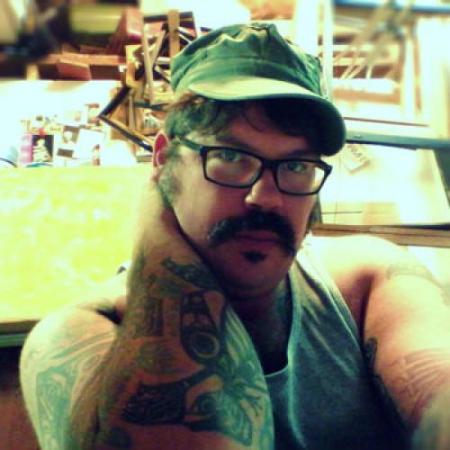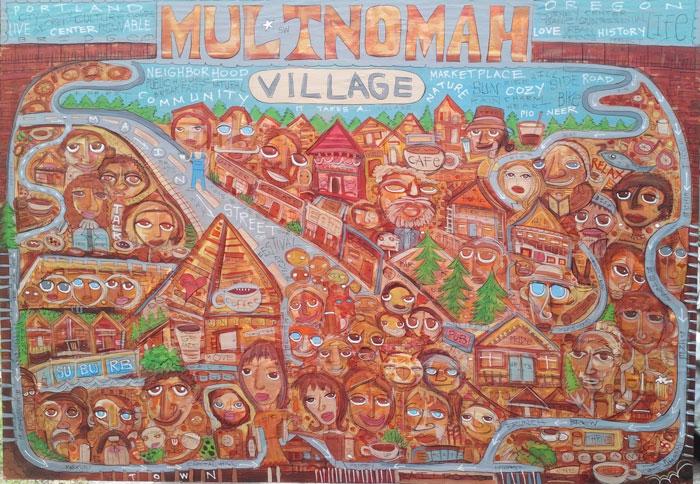The People's Artist: An Interview with Chris Haberman

On a Friday afternoon in October, the People's Art of Portland Gallery in the Pioneer Place Mall awaited its driving force. Artist and volunteer Fred Swan manned the counter, answering visitor questions. Conceptual artist and film maker Adam Bailey set up equipment, ready to film an interview with EMEK, the renowned poster artist whose work hung on the walls. And I fiddled with my laptop while we all waited for gallery owner Chris to make his appearance.
Eventually Chris hustled in, apologizing for being stuck in traffic. A ball of energy, he consulted with Adam about the video, talked to Fred, ate a few bites of bagel with cream cheese, and readied himself for my questions. Chris lives an overbooked life. And gets more done in a day than many artists achieve in a month.
For the People
Back when Chris was getting his master’s in American literature, he expected to be a writer. But his interest in art compelled him to audit art classes. Soon he was painting. Always in search of cheap art materials, Chris dragged home a refrigerator box. He’d paint it, take a picture, then repaint it.
Chris found his niche during his first art show. On opening night, he sold four paintings at the teeny Limelight bar in Sellwood. “I brought all my art down there and had a little party,” he said. “It was very interactive with everyone there. My stuff was really kind of nuts.” His paintings featured lots of text, abstraction and low prices.
“Two weeks later, all my art was gone. The owner handed me a bunch of money and asked if I had more paintings.”
For Chris, interaction was key. He hung out at the Limelight. “People told me a story, I did a painting.” He sold paintings to people who’d never bought artwork before. During ten months of showing at the Limelight, Chris sold 190 paintings.
“I always retained that experience, and tried to always show in bars and places that just regular folks are in,” said Chris. “I give people a lot of credit. The non-art crowd knows more than the art crowd a lot of times.”
Chris’ Work
The older Chris gets, the more he appreciates his home town history. He grew up just outside Portland in Milwaukie and the area’s stories show up in his paintings and murals around town. He’s painted the Shanghai tunnels, local ghosts and murders, the old insane asylum on Hawthorne, Mary’s Club, “anything that shows a little bit of the underground of Portland,” he said.
His work tells stories by layering paint upon paint and image upon image. “I have a literature background so I was turned rotten by James Joyce and William Faulkner. The layering,” he said. When he starts a painting, he’s never sure where it will go. “When I paint, everything is very chaotic at first.” Eventually he pulls the abstract shapes together.

Chris sees the bulk of his audience as people between 20 and 50 who like a comic book style of art. Even when he’s painting very serious subject matter, such as AIDS or homelessness, his approach is still cartoonish and friendly.
To keep costs down, Chris uses house paint for underpainting. People give him leftover paint all the time. For the top layers he uses student grade acrylics. Brush and ink provide finishing touches.
Chris is ridiculously prolific. “Last December I sold my ten thousandth piece,” he said. He also donates about 150 paintings per year to charity. At the time of our interview, he had 120 paintings in progress, 100 of which he planned to finish for his ‘Toons, Totems and Trickery show at People’s the following week.
Overbooking is his key to productivity. “I think that the last minute stuff I do, there’s an over-creative stimulus happening in my brain and I can pump it out.” Last year he had 91 shows of his work, 40 of which were group shows.
The People’s Gallery
In 2010, Chris got an interesting offer from a relative who owns Pioneer Place. A whole upper floor was deserted, which never looks good for a mall. Chris got a screaming deal for the People’s Gallery. And he used it to promote not just himself but thousands of other artists. This gallery lives up to its name.
Chris attributes much of the gallery’s success to the volunteers who staff it. He’s also continually inspired by his business partner, Jason Brown, who also curates the Goodfoot Gallery. “I couldn’t do anything without Jason. We really gel. He can do certain things. I can do certain things. It’s hard to have a partner in the art world. There’s a lot of ego going on.”
While Chris would rather spend more time in his studio painting, he knows he contributes most to the local art scene by running the gallery. He probably wouldn’t come right out and say it, but he has way more business sense than most artists. And he knows how to do all the behind-the-scenes activities, like marketing and setting up shows. “I wasn’t planning on doing any of this,” he said. “But it’s a good thing to help people out. Being an artist, nobody taught me how to do anything. So I think I’m passing it on to other people.” Going to business school would better prepare artists for their careers than going to art school, he said.
Big 400
Perhaps the gallery’s best loved show is the annual Big 100. No, Big 200. No, this year it’s grown to be the Big 400. That means 400 different artists all produce 5 to 10 works on 8 inch by 8 inch wooden panels. Each piece sells for $40, with proceeds divided between the artist (who gets $30), the gallery and the Oregon Food Bank. Most of the action happens on opening day, when people line up waiting for the gallery to unlock the doors and let shoppers throng in. The paintings are all mixed up, so if you’re looking for a favorite artist you have to search through thousands of paintings. Collectors scramble around, trying to get amazing deals on work by their favorite local artists. It’s such a big show that Chris starts working on it in February every year.
Despite the low price point, artists make excellent work for the show, Chris said. Since many of the shoppers are artists, they want to impress each other. And nobody wants to haul home an armload of unsold work.
Chris loves the egalitarian nature of the Big 400. “Everything hangs on the wall together,” he said. He enjoys the wide range of styles and experience levels. This year’s artists range in age from 4 to 84. Some have work hanging in museums. Some are recruited in unexpected circumstances. “I met some tattoo artists at Plaid Pantry last week,” Chris said. “I gave them some panels out of my car.”
What’s on tap for next year? The Big 500, of course. The more inclusive Chris can be, the better. “I love all types of art. And I think encouragement is really important.” Chris, Jason and many of the artists they’ve worked with have felt snubbed by the art scene at various times, he said. But now he’s happy to be running an art gallery by the people and for the people. “We’re an avant garde gallery inside of a mall, which is pretty nuts.”
See what’s showing at the People’s Art: http://www.peoplesartofportland.com/